A Hybrid Analytic Network Process and Artificial Neural Network (ANP-ANN) Model for Urban Earthquake Vulnerability Assessment
Abstract
1. Introduction
2. Related Research
3. Materials and Methods
3.1. Study Area Characteristic
3.2. Data Acquisition, Classification and Standardization
- W: Weight given by respondents to each factor and range between 1 and 5,
- A: Maximum weight, in this case, A = 5,
- N: Number of respondents.
3.2.1. Description of the Selected Indicators
Environmental Indicators
Social Indicators
Economic Indicators
Physical Indicators
3.3. Transferring Layers to IDRISI Software
3.4. Analytic Network Process (ANP) Approach
3.4.1. Step A: ANP Model Construction and Problem Structuring
3.4.2. Step B: Paired Comparisons
3.4.3. Step C: Super Matrix Calculation
3.4.4. Step D: Selection
3.5. Artificial Neural Network
4. Results
4.1. Applying ANP for Training Site
4.2. Calculating Vulnerability Index Score for Training Site
4.3. Applying Multi-Layer Perceptron (MLP) Network for Earthquake Vulnerability Map (EVM)
4.4. Investigating the Accuracy of the Obtained Results
5. Discussion
6. Conclusions
Author Contributions
Funding
Acknowledgments
Conflicts of Interest
References
- Chang, L.F.; Huang, S.L. Assessing urban flooding vulnerability with an emergy approach. Landsc. Urban Plan. 2015, 143, 11–24. [Google Scholar] [CrossRef]
- Cutter, S.L. Vulnerability to environmental hazards. Prog. Hum. Geogr. 1996, 20, 529–539. [Google Scholar] [CrossRef]
- De Andrade, M.M.N.; Claudio, F.S. Vulnerability assessment including tangible and intangible components in the index composition: An Amazon case study of flooding and flash flooding. Sci. Total Environ. 2018, 630, 903–912. [Google Scholar] [CrossRef] [PubMed]
- De Lange, H.J.; Sala, S.; Vighi, M.; Faber, J.H. Ecological vulnerability in risk assessment—A review and perspectives. Sci. Total Environ. 2010, 408, 3871–3879. [Google Scholar] [CrossRef] [PubMed]
- GLP. Science Plan and Implementation Strategy; IGBP Report No.53/IHDP Report No. 19; GLP: Stockholm, Sweden, 2005. [Google Scholar]
- Hagenlocher, M.; Renaud, F.G.; Haas, S.; Sebesvari, Z. Vulnerability and risk of deltaic social-ecological systems exposed to multiple hazards. Sci. Total Environ. 2018, 631–632, 71–80. [Google Scholar] [CrossRef] [PubMed]
- Hinkel, J. Indicators of vulnerability and adaptive capacity: Towards a clarification of the science–policy interface. Glob. Environ. Chang. 2011, 21, 198–208. [Google Scholar] [CrossRef]
- Urbanization and Global Environmental Change (UGEC). Science Plan; IHDP Report No. 15; UGEC: Bonn, Germany, 2005. [Google Scholar]
- Turner, B.L.; Kasperson, R.E.; Matson, P.A.; McCarthy, J.J.; Corell, R.W.; Christensen, L.; Eckley, N.; Kasperson, J.X.; Luers, A.; Martello, M.L.; et al. A framework for vulnerability analysis in sustainability science. Proc. Natl. Acad. Sci. USA 2003, 100, 8074–8079. [Google Scholar] [CrossRef] [PubMed]
- Wisner, B.; Blaikie, P.; Cannon, T.; Davis, I. At Risk: Natural Hazards, People’s Vulnerability, and Disasters; Routledge: London, UK, 2004. [Google Scholar]
- Rashed, T.; Weeks, J. Assessing vulnerability to earthquake hazards through spatial multicriteria analysis of urban areas. Int. J. Geogr. Inf. Sci. 2003, 17, 547–576. [Google Scholar] [CrossRef]
- Morales-Esteban, A.; Martínez-Álvarez, F.; Reyes, J. Earthquake prediction in seismogenic areas of the Iberian Peninsula based on computational intelligence. Tectonophysics 2013, 593, 121–134. [Google Scholar] [CrossRef]
- Oliveira, C.S. Seismic vulnerability of historical constructions: A contribution. Bull. Earthq. Eng. 2003, 1, 37–82. [Google Scholar] [CrossRef]
- D’Ayala, D.F.; Carriero, A.; Sabbadini, F.; Fanciullacci, D.; Ozelik, P.; Akdogan, M.; Kaya, Y. Seismic Vulnerability and Risk Assessment of Cultural Heritage Buildings in Istanbul, Turkey. In Proceedings of the 14th World Conference on Earthquake Engineering, Beijing, China, 12–17 October 2008; Volume 3. [Google Scholar]
- Bakirtas, T.; Akpolat, A.G. The relationship between energy consumption, urbanization, and economic growth in new emerging-market countries. Energy 2018, 147, 110–121. [Google Scholar] [CrossRef]
- Duzgun, H.S.B.; Yucemen, M.S.; Kalaycioglu, H.S.; Celik, K.; Kemec, S.; Ertugay, K.; Deniz, A. An integrated earthquake vulnerability assessment framework for urban areas. Nat. Hazards 2011, 59, 917–947. [Google Scholar] [CrossRef]
- He, C.; Chen, T.; Mao, X.; Zhou, Y. Economic transition, urbanization and population redistribution in China. Habitat Int. 2016, 51, 39–47. [Google Scholar] [CrossRef]
- Hendricksa, M.D.; Meyerb, M.A.; Gharaibehc, N.G.; Zandtd, S.V.; Mastersond, J.; Cooper, J.T.; Horneye, J.A.; Berked, P. The development of a participatory assessment technique for infrastructure: Neighborhood-level monitoring towards sustainable infrastructure systems. Sustain. Cities Soc. 2018, 38, 265–274. [Google Scholar] [CrossRef]
- Marrone, S.; Nardone, R.; Tedesco, A.; D’Amore, P.; Vittorini, V.; Setola, R.; De Cillis, F.; Mazzocca, N. Vulnerability modeling and analysis for critical infrastructure protection applications. Int. J. Crit. Infrastruct. Protect. 2013, 6, 217–227. [Google Scholar] [CrossRef]
- Tucker, B.E.; Trumbull, J.G.; Wyss, S.J. Some remarks concerning worldwide urban earthquake hazard and earthquake hazard mitigation. In Issues in Urban Earthquake Risk; Springer: Dordrecht, The Netherlands, 1994; pp. 1–10. [Google Scholar]
- Alarifi, A.S.; Alarifi, N.S.; Al-Humidan, S. Earthquakes magnitude predication using artificial neural network in northern Red Sea area. J. King Saud Univ. Sci. 2012, 24, 301–313. [Google Scholar] [CrossRef]
- Adeli, H.; Panakkat, A. A probabilistic neural network for earthquake magnitude prediction. Neural Netw. 2009, 22, 1018–1024. [Google Scholar] [CrossRef] [PubMed]
- Erzin, Y.; Cetin, T. The use of neural networks for the prediction of the critical factor of safety of an artificial slope subjected to earthquake forces. Sci. Iran. 2012, 19, 188–194. [Google Scholar] [CrossRef]
- Mirrashid, M. Earthquake magnitude prediction by adaptive neuro-fuzzy inference system (ANFIS) based on fuzzy C-means algorithm. Nat. Hazards 2014, 74, 1577–1593. [Google Scholar] [CrossRef]
- Moustra, M.; Avraamides, M.; Christodoulou, C. Artificial neural networks for earthquake prediction using time series magnitude data or Seismic Electric Signals. Expert Syst. Appl. 2011, 38, 15032–15039. [Google Scholar] [CrossRef]
- Prajapati, S.K.; Dadhich, H.K.; Chopra, S. Isoseismal map of the 2015 Nepal earthquake and its relationships with ground-motion parameters, distance and magnitude. J. Asian Earth Sci. 2017, 133, 24–37. [Google Scholar] [CrossRef]
- Tavakoli, B. Sensitivity of seismic hazard evaluations to uncertainties determined from seismic source characterization. J. Seismol. 2002, 6, 525–545. [Google Scholar] [CrossRef]
- Yousefi, M.; Taghikhany, T. Incorporation of directivity effect in probabilistic seismic hazard analysis and disaggregation of Tabriz city. Nat. Hazards 2014, 73, 277–301. [Google Scholar] [CrossRef]
- Zamani, A.; Sorbi, M.R.; Safavi, A.A. Application of neural network and ANFIS model for earthquake occurrence in Iran. Earth Sci. Inf. 2013, 6, 71–85. [Google Scholar] [CrossRef]
- Menoni, S. Chains of damages and failures in a metropolitan environment: Some observations on the Kobe earthquake in 1995. J. Hazard. Mater. 2001, 86, 101–119. [Google Scholar] [CrossRef]
- Giacinto, G.; Paolucci, R.; Roli, F. Application of neural networks and statistical pattern recognition algorithms to earthquake risk evaluation. Pattern Recognit. Lett. 1997, 18, 1353–1362. [Google Scholar] [CrossRef]
- Irwansyah, E.; Hartati, S. Zonation of Earthquake Building Damage Hazard Area Using Kohonen Neural Network (NN) and Kriging Algorithm. Adv. Nat. Appl. Sci. 2014, 8, 120–124. [Google Scholar]
- Karimzadeh, S.; Cakir, Z.; Osmanoğlu, B.; Schmalzle, G.; Miyajima, M.; Amiraslanzadeh, R.; Djamour, Y. Interseismic strain accumulation across the North Tabriz Fault (NW Iran) deduced from InSAR time series. J. Geodyn. 2013, 66, 53–58. [Google Scholar] [CrossRef]
- Karimzadeh, S.; Miyajima, M.; Hassanzadeh, R.; Amiraslanzadeh, R.; Kamel, B. A GIS-based seismic hazard, building vulnerability and human loss assessment for the earthquake scenario in Tabriz. Soil Dyn. Earthq. Eng. 2014, 66, 263–280. [Google Scholar] [CrossRef]
- Kappos, A.J.; Panagopoulos, G.K.; Sextos, A.G.; Papanikolaou, V.K.; Stylianidis, K.C. Development of comprehensive earthquake loss scenarios for a Greek and a Turkish city-structural aspects. Earthq. Struct. 2010, 1, 197–214. [Google Scholar] [CrossRef]
- McGowan, S.M.; Jaiswal, K.S.; Wald, D.J. Using structural damage statistics to derive macroseismic intensity within the Kathmandu valley for the 2015 M7.8 Gorkha, Nepal earthquake. Tectonophysics 2017, 714–715, 158–172. [Google Scholar] [CrossRef]
- Tavakoli, B.; Ghafory-Ashtiany, M. Seismic hazard assessment of Iran. Ann. Geophys. 1999, 42, 123–135. [Google Scholar]
- Vicente, R.; Parodi, S.; Lagomarsino, S.; Varum, H.; Silva, J.M. Seismic vulnerability and risk assessment: Case study of the historic city centre of Coimbra, Portugal. Bull. Earthq. Eng. 2011, 9, 1067–1096. [Google Scholar] [CrossRef]
- Aradag, S.; Genc, Y.; Turk, C. Comparative gasketed plate heat exchanger performance prediction with computations, experiments, correlations and artificial neural network estimations. Eng. Appl. Comput. Fluid Mech. 2017, 11, 467–482. [Google Scholar] [CrossRef]
- Taormina, R.; Chau, K.W.; Sivakumar, B. Neural network river forecasting through baseflow separation and binary-coded swarm optimization. J. Hydrol. 2015, 529, 1788–1797. [Google Scholar] [CrossRef]
- Hajihassani, M.; Armaghani, D.J.; Marto, A.; Mohamad, E.T. Ground vibration prediction in quarry blasting through an artificial neural network optimized by imperialist competitive algorithm. Bull. Eng. Geol. Environ. 2015, 74, 873–886. [Google Scholar] [CrossRef]
- Chau, K.W. Reliability and performance-based design by artificial neural network. Adv. Eng. Softw. 2007, 38, 145–149. [Google Scholar] [CrossRef]
- Gordan, B.; Armaghani, D.J.; Hajihassani, M.; Monjezi, M. Prediction of seismic slope stability through combination of particle swarm optimization and neural network. Eng. Comput. 2016, 32, 85–97. [Google Scholar] [CrossRef]
- Hinton, G.E. How neural networks learn from experience. Sci. Am. 1992, 267, 145–151. [Google Scholar] [CrossRef]
- Jensen, B. Expert systems-neural networks. In Instrument Engineers’ Handbook, 3rd ed.; Chilton: Radnor, PA, USA, 1994. [Google Scholar]
- Bishop, C.M. Neural Networks for Pattern Recognition; Oxford University Press: Oxford, UK, 1995. [Google Scholar]
- Liang, Z.; Shan, S.; Liu, X.; Wen, Y. Fuzzy prediction of AWJ turbulence characteristics by using typical multi-phase flow models. Eng. Appl. Comput. Fluid Mech. 2017, 11, 225–257. [Google Scholar] [CrossRef]
- Islam, M.S.; Mohandes, M.; Rehman, S. Vertical extrapolation of wind speed using artificial neural network hybrid system. Neural Comput. Appl. 2017, 28, 2351–2361. [Google Scholar] [CrossRef]
- Sharma, M.; Purohit, G.N.; Mukherjee, S. Information Retrieves from Brain MRI Images for Tumor Detection Using Hybrid Technique K-means and Artificial Neural Network (KMANN). In Networking Communication and Data Knowledge Engineering; Springer: Singapore, 2018; pp. 145–157. [Google Scholar]
- Haykin, S. Multilayer perceptrons. Neural Netw. 1999, 2, 156–255. [Google Scholar]
- Lee, S.; Ryu, J.H.; Lee, M.J.; Won, J.S. Use of an artificial neural network for analysis of the susceptibility to landslides at Boun, Korea. Environ. Geol. 2003, 44, 820–833. [Google Scholar] [CrossRef]
- Lee, S.; Ryu, J.H.; Won, J.S.; Park, H.J. Determination and application of the weights for landslide susceptibility mapping using an artificial neural network. Eng. Geol. 2004, 71, 289–302. [Google Scholar] [CrossRef]
- Field, E. Urban Property Rights and Labor Supply in Peru. Q. J. Econ. 2007, 122, 1561–1602. [Google Scholar] [CrossRef]
- Mili, R.R.; Hosseini, K.A.; Izadkhah, Y.O. Developing a holistic model for earthquake risk assessment and disaster management interventions in urban fabrics. Int. J. Disaster Risk Reduct. 2018, 27, 355–365. [Google Scholar] [CrossRef]
- Bahadori, H.; Hasheminezhad, A.; Karimi, A. Development of an integrated model for seismic vulnerability assessment of residential buildings: Application to Mahabad City, Iran. J. Build. Eng. 2017, 12, 118–131. [Google Scholar] [CrossRef]
- Zhang, Y.; van den Berg, A.E.; Dijk, T.V.; Weitkamp, G. Quality over Quantity: Contribution of Urban Green Space to Neighborhood Satisfaction. Int. J. Environ. Res. Public Health 2017, 14, 535. [Google Scholar] [CrossRef] [PubMed]
- Karimzadeh, S.; Kadas, K.; Askan, A.; Erberik, M.A.; Yakut, A. A study on fragility analyses of masonry buildings in Erzincan (Turkey) utilizing simulated and real ground motion records. Procedia Eng. 2017, 199, 188–193. [Google Scholar] [CrossRef]
- Armas, I.; Toma-Danila, D.; Ionescu, R.; Gavirs, A. Vulnerability to Earthquake Hazard: Bucharest Case Study, Romania. Int. J. Disaster Risk Sci. 2017, 8, 182–192. [Google Scholar] [CrossRef]
- Zebardast, E. Constructing a social vulnerability index to earthquake hazards using a hybrid factor analysis and analytic network process (F’ANP) model. Nat. Hazards 2013, 65, 1331–1359. [Google Scholar] [CrossRef]
- Pradhan, B.; Lee, S. Landslide risk analysis using artificial neural network model focussing on different training sites. Int. J. Phys. Sci. 2009, 4, 1–15. [Google Scholar]
- Panakkat, A.; Adeli, H. Recurrent neural network for approximate earthquake time and location prediction using multiple seismicity indicators. Comput. Aided Civ. Infrastruct. Eng. 2009, 24, 280–292. [Google Scholar] [CrossRef]
- Ghayamghamian, M.R.; Rajool, A. Long-period Ground Motion Simulation for NTF Fault Near-source energy released. In Proceedings of the Fifteenth World Conference on Earthquake Engineering, Lisbon, Portugal, 23–25 March 2012. [Google Scholar]
- Berberian, M. Contribution to the Seismotectonics of Iran (Part II–III): In Commemoration of the 50th Anniversary of the Pahlavi Dynasty; No. 39; Ministry of Industry and Mines, Geological Survey of Iran, Tectonic and Seismotectonic Section: Tehran, Iran, 1976. [Google Scholar]
- Jackson, J. Partitioning of strike-slip and convergent motion between Eurasia and Arabia in eastern Turkey and the Caucasus. J. Geophys. Res. Solid Earth 1992, 97, 12471–12479. [Google Scholar] [CrossRef]
- Wilson, A. Earthquakes in Persia. Bull. Sch. Orient. Stud. Lond. Inst 1930, 6, 103–131. [Google Scholar] [CrossRef]
- Wu, Q.; Ye, S.; Wu, X.; Chen, P. Risk assessment of earth fractures by constructing an intrinsic vulnerability map, a specific vulnerability map, and a hazard map, using Yuci City, Shanxi, China as an example. Environ. Geol. 2004, 46, 104–112. [Google Scholar] [CrossRef]
- Kurttila, M.; Pesonen, M.; Kangas, J.; Kajanus, M. Utilizing the analytic hierarchy process (AHP) in SWOT analysis—A hybrid method and its application to a forest-certification case. For. Policy Econ. 2000, 1, 41–52. [Google Scholar] [CrossRef]
- Kometa, S.T.; Olomolaiye, P.; Harris, F.C. Validation of the model for evaluating client-generated risk by project consultants. Constr. Manag. Econ. 1996, 14, 131–145. [Google Scholar] [CrossRef]
- Shash, A.A.; Abdul-Hadi, H.N. The effect of contractor size on mark-up size decision in Saudi Arabia. Constr. Manag. Econ. 1993, 11, 421–429. [Google Scholar] [CrossRef]
- Adeoye, D.O. Challenges of Urban Housing Quality: Insights and Experiences of Akure, Nigeria. Procedia Soc. Behav. Sci. 2016, 216, 260–268. [Google Scholar] [CrossRef]
- ESRI. Arc GIS Network Analyst Routing, Closest Facility, and Service Area Analysis; ESRI: Redlands, CA, USA, 2005. [Google Scholar]
- Sandi, H. Vulnerability and risk analysis for individual structures and systems. In Proceedings of the 8th European Conference on Earthquake Engineering, Lisbon, Portugal, 7–12 September 1986; pp. 11–60. [Google Scholar]
- Bahrainy, H. Natural disaster management in Iran during the 1990s-need for a new structure. J. Urban Plan. Dev. 2003, 129, 140–160. [Google Scholar] [CrossRef]
- Văcăreanu, R.; Cornea, T.; Lungu, D. Evaluarea comportãrii structurale si a ulnerabilitãtii seismice folosind metodologiile HAZUS si ATC-40 modificat. In A doua Conferintã Nationalã de Inginerie Seismicã; Technical University of Civil Engineering of Bucharest Press: Bucharest, Romania, 2001; Volume 2, pp. 2–16. [Google Scholar]
- Cutter, S.L.; Mitchell, J.T.; Scott, M.S. Revealing the vulnerability of people and places: A case study of Georgetown County, South Carolina. Ann. Assoc. Am. Geogr. 2000, 90, 713–737. [Google Scholar] [CrossRef]
- Cutter, S.L.; Boruff, B.J.; Shirley, W.L. Social vulnerability to environmental hazards. Soc. Sci. Q. 2003, 84, 242–261. [Google Scholar] [CrossRef]
- Cutter, S.L.; Finch, C. Temporal and spatial changes in social vulnerability to natural hazards. Proc. Natl. Acad. Sci. USA 2008, 105, 2301–2306. [Google Scholar] [CrossRef] [PubMed]
- Ebert, A.; Kerle, N.; Stein, A. Urban social vulnerability assessment with physical proxies and spatial metrics derived from air-and spaceborne imagery and GIS data. Nat. Hazards 2009, 48, 275–294. [Google Scholar] [CrossRef]
- Alinia, H.S.; Delavar, M. Tehran’s seismic vulnerability classification using granular computing approach. Appl. Geomat. 2011, 3, 229–240. [Google Scholar] [CrossRef]
- Yildiz, S.; Karaman, H. Post-earthquake ignition vulnerability assessment of Küçükçekmece District. Nat. Hazards Earth Syst. Sci. 2013, 13, 3357–3368. [Google Scholar] [CrossRef]
- Panahi, M.; Rezaie, F.; Meshkani, S.A. Seismic vulnerability assessment of Atmospheric Open Access Atmospheric Measurement school buildings in Tehran city based on Techniques Open Access Discussions AHP and GIS. Nat. Hazards Earth Syst. Sci. 2013, 14, 4511–4538. [Google Scholar] [CrossRef]
- Zaharia, B.; Radulian, M.; Popa, M.; Grecu, B.; Bala, A.; Tataru, D. Estimation of the local response using Nakamura method for Bucharest area. Roman. Rep. Phys. 2008, 60, 131–144. [Google Scholar]
- Tate, E. Social vulnerability indices: A comparative assessment using uncertainty and sensitivity analysis. Nat. Hazards 2012, 63, 325–347. [Google Scholar] [CrossRef]
- Bakhtiari, A. Country Report: The Islamic Republic of Iran on Disaster Risk Management; Iranian National Disaster Management Organization (NDMO) and Visiting Researcher at ADRC: Kobe, Japan, 2014. [Google Scholar]
- Rezaie, F.; Panahi, M. GIS modeling of seismic vulnerability of residential fabrics considering geotechnical, structural, social and physical distance indicators in Tehran using multi-criteria decision-making techniques. Nat. Hazards Earth Syst. Sci. 2015, 15, 461–474. [Google Scholar] [CrossRef]
- Holand, I.S.; Lujala, P.; Rød, J.K. Social vulnerability assessment for Norway: A quantitative approach. Norsk Geografisk Tidsskrift-Norwegian J. Geogr. 2011, 65, 1–17. [Google Scholar] [CrossRef]
- Armaș, I.; Gavriș, A. Social vulnerability assessment using spatial multi-criteria analysis (SEVI model) and the Social Vulnerability Index (SoVI model)—A case study for Bucharest, Romania. Nat. Hazards Earth Syst. Sci. 2013, 13, 1481–1499. [Google Scholar] [CrossRef]
- Binita, K.; Shepherd, J.M.; Gaither, C.J. Climate change vulnerability assessment in Georgia. Appl. Geogr. 2015, 62, 62–74. [Google Scholar]
- Brooks, N.; Adger, W.N.; Kelly, P.M. The determinants of vulnerability and adaptive capacity at the national level and the implications for adaptation. Glob. Environ. Chang. 2005, 15, 151–163. [Google Scholar] [CrossRef]
- Martins, V.N.; e Silva, D.S.; Cabral, P. Social vulnerability assessment to seismic risk using multicriteria analysis: The case study of Vila Franca do Campo (Sao Miguel Island, Azores, Portugal). Nat. Hazards 2012, 62, 385–404. [Google Scholar] [CrossRef]
- Peng, Y. Regional earthquake vulnerability assessment using a combination of MCDM methods. Ann. Oper. Res. 2015, 234, 95–110. [Google Scholar] [CrossRef]
- Asadzadeh, A.; Kötter, T.; Zebardast, E. An augmented approach for measurement of disaster resilience using connective factor analysis and analytic network process (F’ANP) model. Int. J. Disaster Risk Reduct. 2015, 14, 504–518. [Google Scholar] [CrossRef]
- Beck, E.; André-Poyaud, I.; Davoine, P.-A.; Chardonnel, S.; Lutoff, C. Risk perception and social vulnerability to earthquakes in Grenoble (French Alps). J. Risk Res. 2012, 15, 1245–1260. [Google Scholar] [CrossRef]
- Eakin, H.; Bojorquez-Tapia, L.A. Insights into the composition of household vulnerability from multicriteria decision analysis. Glob. Environ. Chang. 2008, 18, 112–127. [Google Scholar] [CrossRef]
- Lungu, D.; Aldea, A.; Arion, C.; Cornea, T.; Vacareanu, R. European distinctive features inventory database and typology. In Proceedings of the International Conference Earthquake Loss Estimation and Risk Reduction 2004, Bucuresti, Romania, 24–26 October 2004; Volume 2, pp. 251–272. [Google Scholar]
- Tanaka, K. The impact of disaster education on public preparation and mitigation for earthquakes: A cross-country comparison between Fukui, Japan and the San Francisco Bay Area, California, USA. Appl. Geogr. 2005, 25, 201–225. [Google Scholar] [CrossRef]
- Sarris, A.; Loupasakis, C.; Soupios, P.; Trigkas, V.; Vallianatos, F. Earthquake vulnerability and seismic risk assessment of urban areas in high seismic regions: Application to Chania City, Crete Island, Greece. Nat. Hazards 2010, 54, 395–412. [Google Scholar] [CrossRef]
- Debnath, R. An assessment of spatio-temporal pattern of urban earthquake vulnerability using GIS: A study on Dhaka City. Ann. GIS 2013, 19, 63–78. [Google Scholar] [CrossRef]
- Armaş, I. Earthquake risk perception in Bucharest, Romania. Risk Anal. 2006, 26, 1223–1234. [Google Scholar] [CrossRef] [PubMed]
- Armaş, I. Social vulnerability and seismic risk perception. Case study: The historic center of the Bucharest Municipality/Romania. Nat. Hazards 2008, 47, 397–410. [Google Scholar] [CrossRef]
- Armaş, I.; Avram, E. Perception of flood risk in Danube Delta, Romania. Nat. Hazards 2009, 50, 269–287. [Google Scholar] [CrossRef]
- Armaş, I. Multi-criteria vulnerability analysis to earthquake hazard of Bucharest, Romania. Nat. Hazards 2012, 63, 1129–1156. [Google Scholar] [CrossRef]
- Armaş, I.; Ionescu, R.; Garivs, A.; Toma-Danila, D. Identifying seismic vulnerability hotspots in Bucharest. Appl. Geogr. 2016, 77, 49–63. [Google Scholar] [CrossRef]
- Ma, J.; Qin, S. Automatic depicting algorithm of earthquake collapsed buildings with airborne high resolution image. In Proceedings of the IEEE International Geoscience and Remote Sensing Symposium, Munich, Germany, 22–27 March 2012; pp. 939–942. [Google Scholar]
- Hizbaron, D.R.; Baiquni, M.; Sartohadi, J.; Rijanta, R. Urban Vulnerability in Bantul District, Indonesia—Towards Safer and Sustainable Development. Sustainability 2012, 4, 2022–2037. [Google Scholar] [CrossRef]
- Toro, J.; Duarte, O.; Requena, I.; Zamorano, M. Determining vulnerability importance in environmental impact assessment: The case of Colombia. Environ. Impact Assess. Rev. 2012, 32, 107–117. [Google Scholar] [CrossRef]
- Davidson, R.A.; Shah, H.C. An Urban Earthquake Disaster Risk Index; Blume, J.H., Ed.; Standford University, Earthquake Engineering Center: Standford, CA, USA, 1997. [Google Scholar]
- Davidson, D.J.; Freudenburg, W.R. Gender and environmental risk concern a review and analysis of available research. Environ. Behav. 1996, 28, 302–339. [Google Scholar] [CrossRef]
- Krishnamurthy, P.K.; Krishnamurthy, L. Social Vulnerability Assessment through GIS Techniques: A Case Study of Flood Risk Mapping in Mexico. In Geospatial Techniques for Managing Environmental Resources; Springer: Dordrecht, The Netherlands, 2011; pp. 276–291. [Google Scholar]
- Shepard, C.C.; Agostini, V.N.; Gilmer, B.; Allen, T.; Stone, J.; Brooks, W.; Beck, M.W. Assessing future risk: Quantifying the effects of sea level rise on storm surge risk for the southern shores of Long Island, New York. Nat. Hazards 2012, 60, 727–745. [Google Scholar] [CrossRef]
- Granger, K.; Jones, T.G.; Leiba, M.; Scott, G. Community Risk in Cairns: A Multi-Hazard Risk Assessment; Australian Geological Survey Organisation: Canberra, Australian, 1999; pp. 678–689.
- King, D.; MacGregor, C. Using social indicators to measure community vulnerability to natural hazards. Aust. J. Emerg. Manag. 2000, 15, 52–67. [Google Scholar]
- Saaty, T.L. Analytical Network Process; RWS Publications: Pittsburgh, PA, USA, 1996. [Google Scholar]
- Marasco, A. Third-party logistics: A literature review. Int. J. Prod. Econ. 2008, 113, 127–147. [Google Scholar] [CrossRef]
- Chung, S.H.; Lee, A.H.I.; Pearn, W.L. Analytic network process (ANP) approach for product mix planning in semiconductor fabricator. Int. J. Prod. Econ. 2005, 96, 15–36. [Google Scholar] [CrossRef]
- Bojórquez, E.; Bojórquez, J.; Ruiz, S.E.; Reyes-Salazar, A. Prediction of inelastic response spectra using artificial neural networks. Math. Probl. Eng. 2012, 34, 236–248. [Google Scholar] [CrossRef]
- Cheng, J.; Li, Q.S. Reliability analysis of structures using artificial neural network based genetic algorithms. Comput. Methods Appl. Mech. Eng. 2008, 197, 3742–3750. [Google Scholar] [CrossRef]
- Günaydın, K.; Günaydın, A. Peak ground acceleration prediction by artificial neural networks for northwestern Turkey. Math. Probl. Eng. 2008, 2008, 919420. [Google Scholar] [CrossRef]
- Ergu, D.; Kou, G.; Shi, Y.; Shi, Y. Analytic network process in risk assessment and decision analysis. Comput. Oper. Res. 2014, 42, 58–74. [Google Scholar] [CrossRef]
- Meade, L.M.; Sarkis, J. Analyzing organizational project alternatives for agile manufacturing processes: An analytical network approach. Int. J. Prod. Res. 1999, 37, 241–261. [Google Scholar] [CrossRef]
- Lee, H.; Kim, M.S.; Park, Y. An analytic network process approach to operationalization of five forces model. Appl. Math. Model. 2012, 36, 1783–1795. [Google Scholar] [CrossRef]
- Sahoo, S.; Dhar, A.; Kar, A. Environmental vulnerability assessment using Grey Analytic Hierarchy Process based model. Environ. Impact Assess. Rev. 2016, 56, 145–154. [Google Scholar] [CrossRef]
- Antanasijević, D.Z.; Pocajt, V.V.; Povrenović, D.S.; Ristić, M.Đ.; Perić-Grujić, A.A. PM 10 emission forecasting using artificial neural networks and genetic algorithm input variable optimization. Sci. Total Environ. 2013, 443, 511–519. [Google Scholar] [CrossRef] [PubMed]
- Nedic, V.; Despotovic, D.; Cvetanovic, S.; Despotovic, M.; Babic, S. Comparison of classical statistical methods and artificial neural network in traffic noise prediction. Environ. Impact Assess. Rev. 2014, 49, 24–30. [Google Scholar] [CrossRef]
- Hagan, M.T.; Demuth, H.B.; Beale, M. Neural Network Design; PWS Pub.: Boston, MA, USA, 1996. [Google Scholar]
- Paola, J.D.; Schowengerdt, R.A. A review and analysis of backpropagation neural networks for classification of remotely-sensed multi-spectral imagery. Int. J. Remote Sens. 1995, 16, 3033–3058. [Google Scholar] [CrossRef]
- Atkinson, P.M.; Tatnall, A.R.L. Introduction neural networks in remote sensing. Int. J. Remote Sens. 1997, 18, 699–709. [Google Scholar] [CrossRef]
- Gong, P. Integrated analysis of spatial data for multiple sources: Using evidential reasoning and artificial neural network techniques for geological mapping. Photogramm. Eng. Remote Sens. 1996, 62, 513–523. [Google Scholar]
- Abraham, A. Artificial neural networks. In Handbook of Measuring System Design; Wiley: Chichester, UK, 2005. [Google Scholar]
- Pradhan, B.; Lee, S. Regional landslide susceptibility analysis using back-propagation neural network model at Cameron Highland, Malaysia. Landslides 2010, 7, 13–30. [Google Scholar] [CrossRef]
- Cardona, O.D.; van Aalst, M.K.; Birkmann, J.; Fordham, M.; McGregor, G.; Mechler, R. Determinants of Risk: Exposure and Vulnerability; Cambridge University Press: Cambridge, UK, 2012; pp. 54–76. [Google Scholar]
- Pelling, M.; Wisner, B. Disaster Risk Reduction: Cases from Urban Africa; Routledge: London, UK, 2012. [Google Scholar]
- Villegas-González, P.A.; Ramos-Cañón, A.M.; González-Méndez, M.; González-Salazar, R.E.; De Plaza-Solórzano, J.S. Territorial vulnerability assessment frame in Colombia: Disaster risk management. Int. J. Disaster Risk Reduct. 2017, 21, 384–395. [Google Scholar] [CrossRef]
- Steinführer, A. Social Vulnerability and the 2002 Flood; Country Report Germany (Mulde River); Helmholz Unweltforschungszentrum (UFZ): Berlin, Germany, 2007. [Google Scholar]
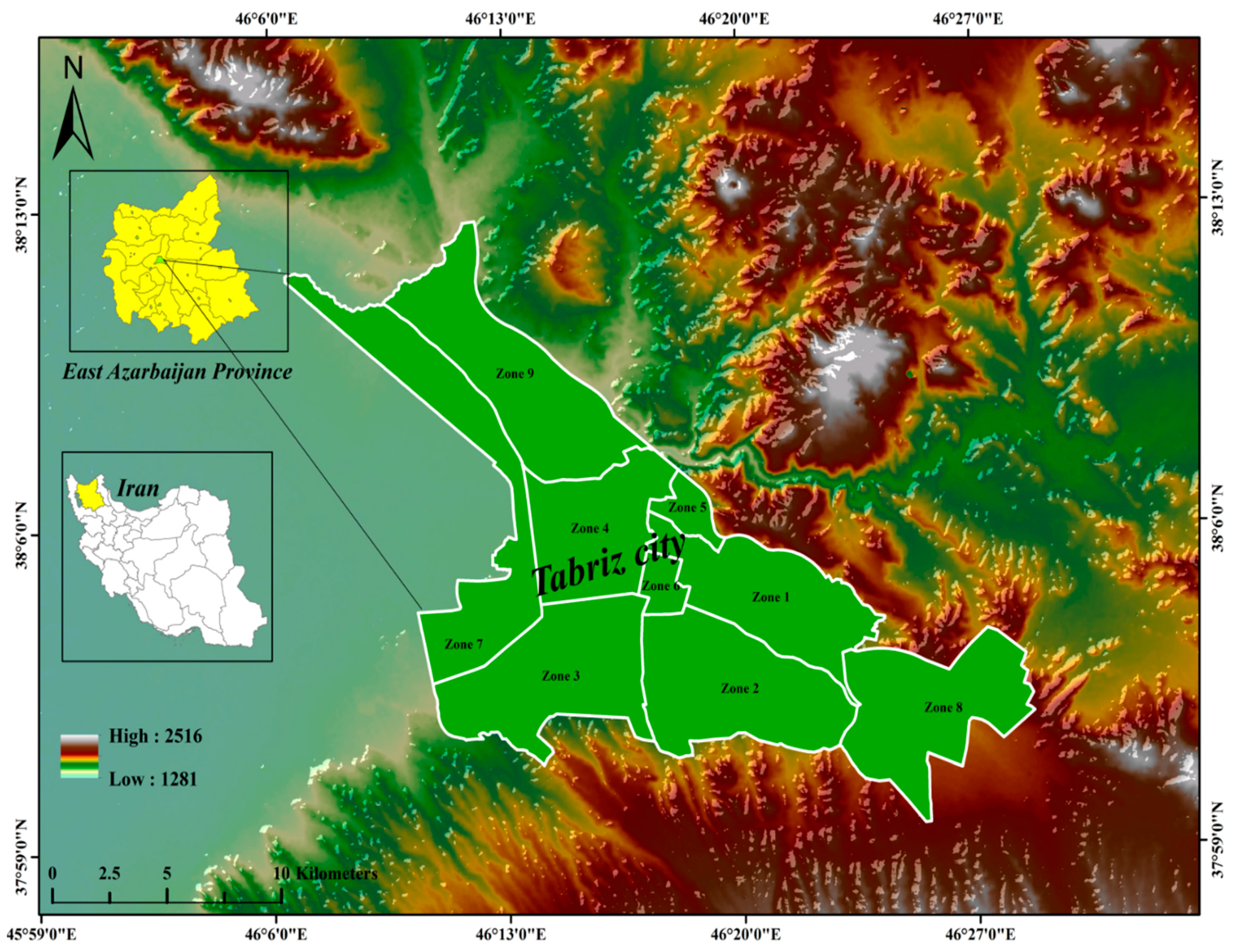
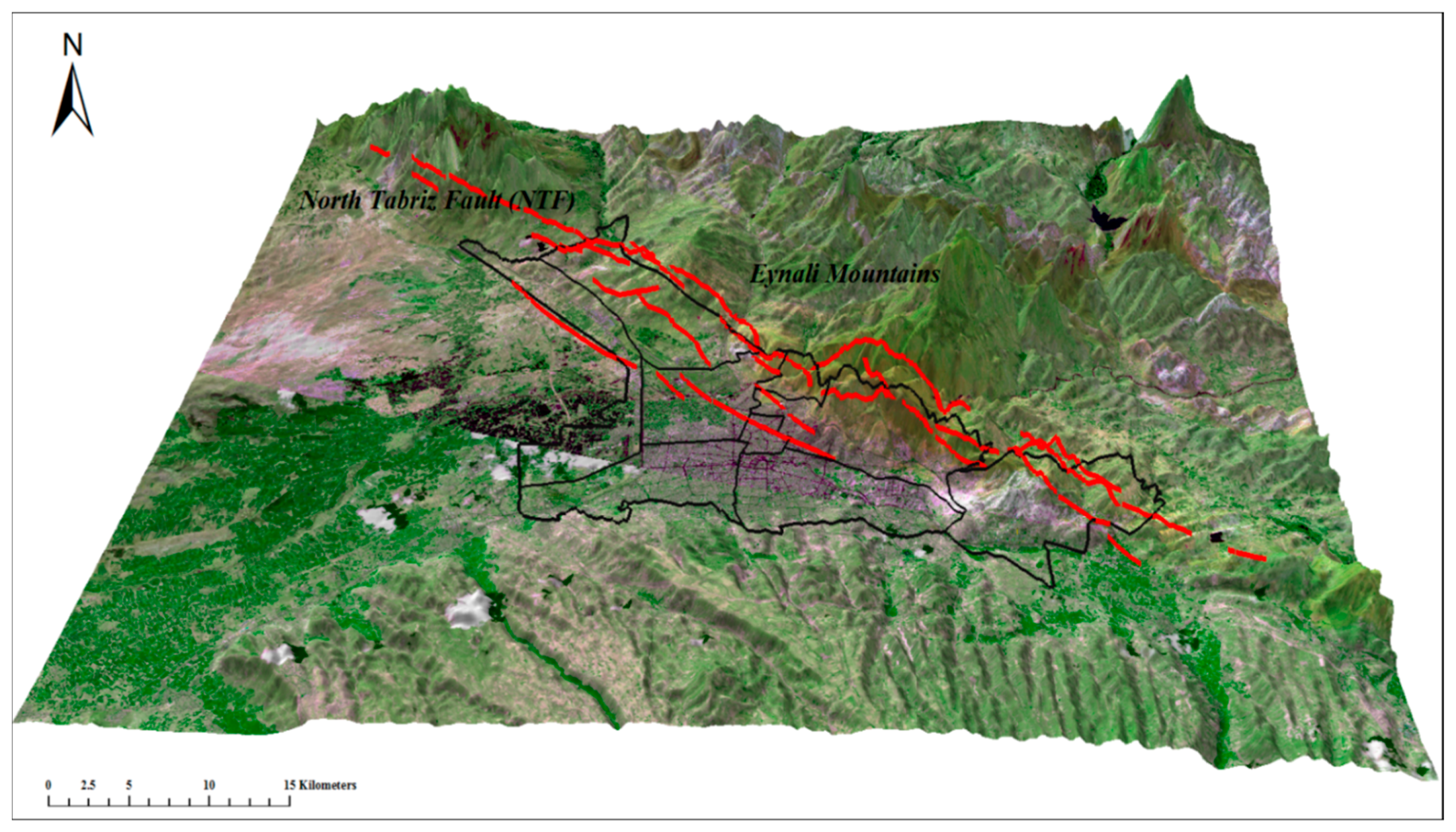
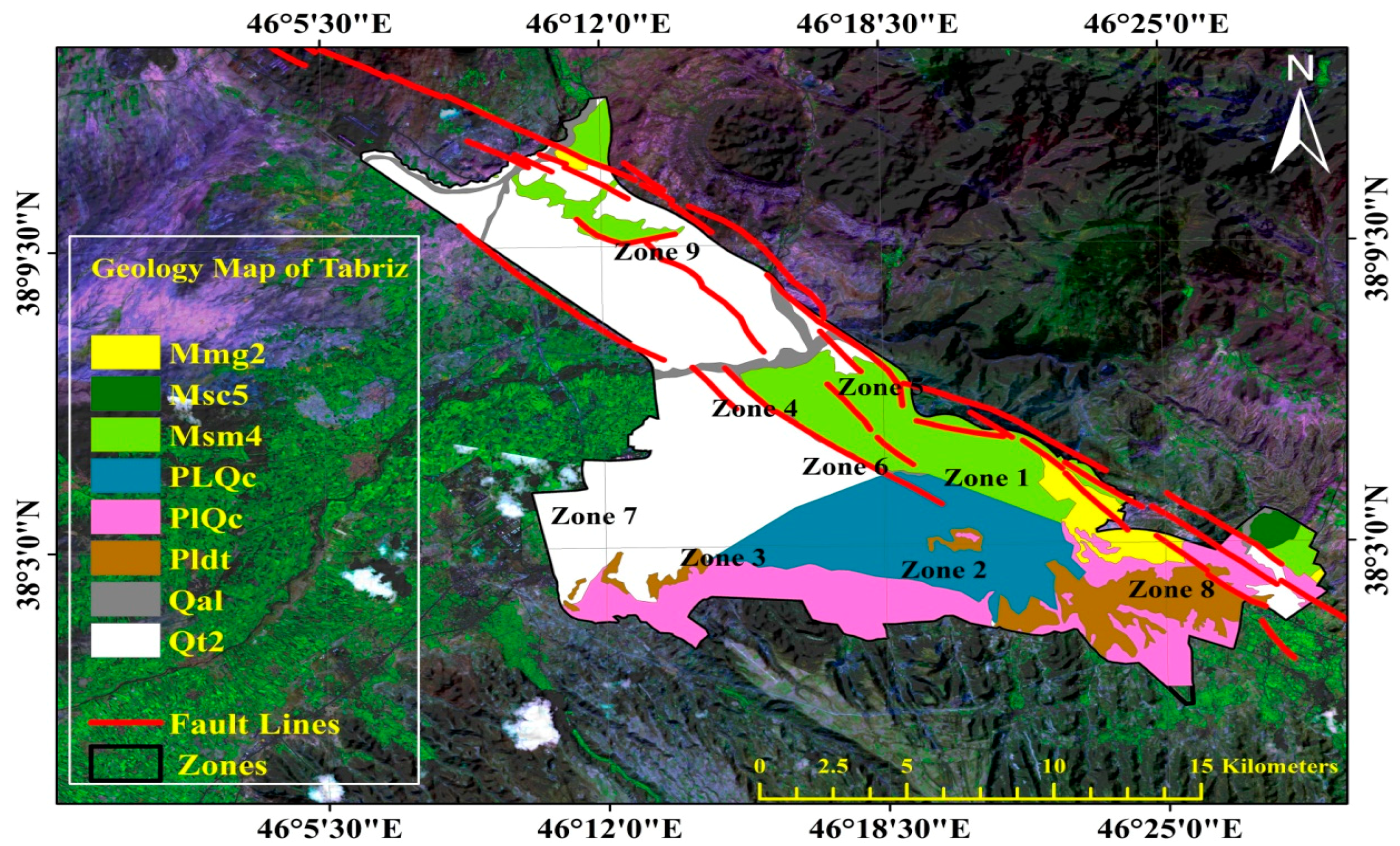
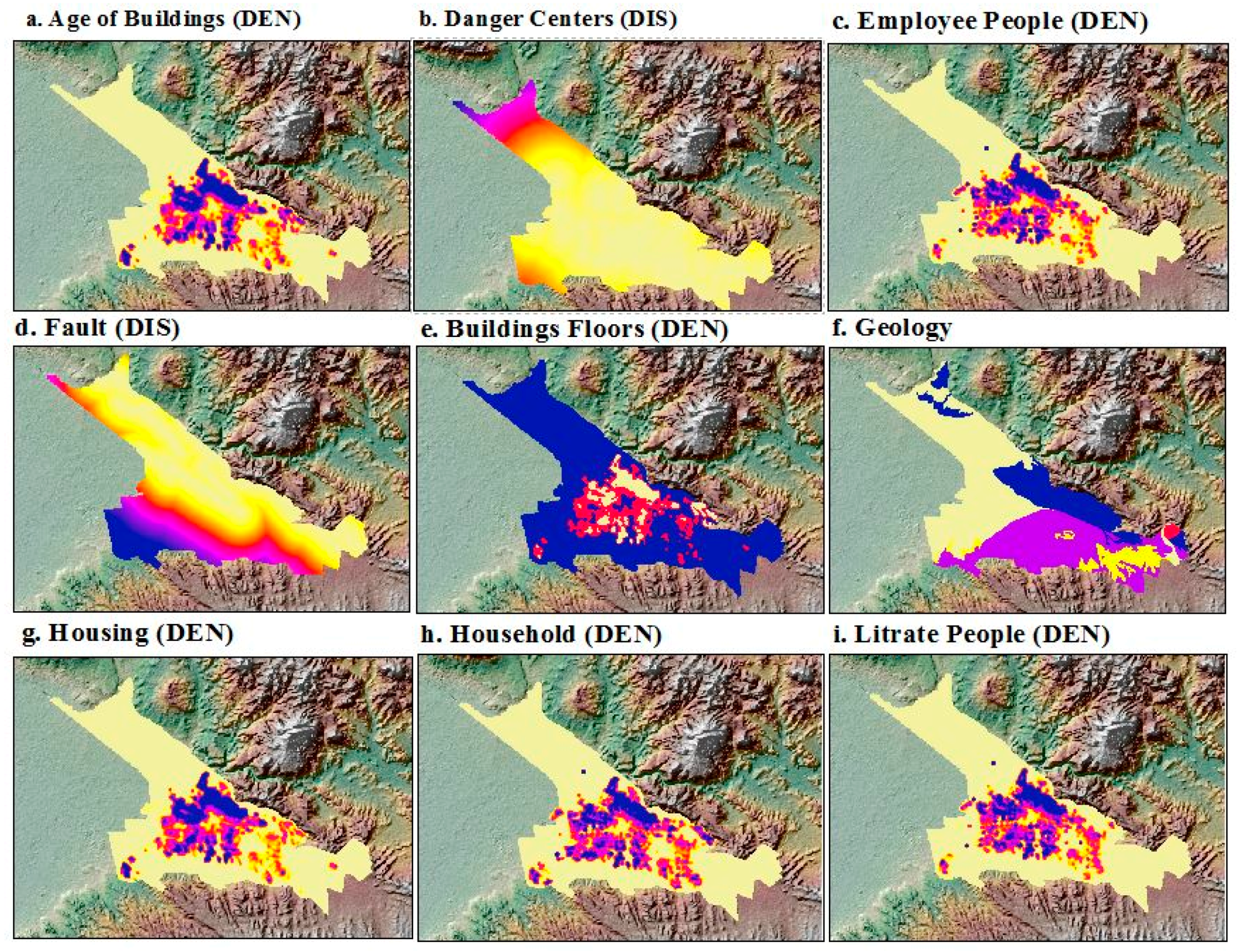
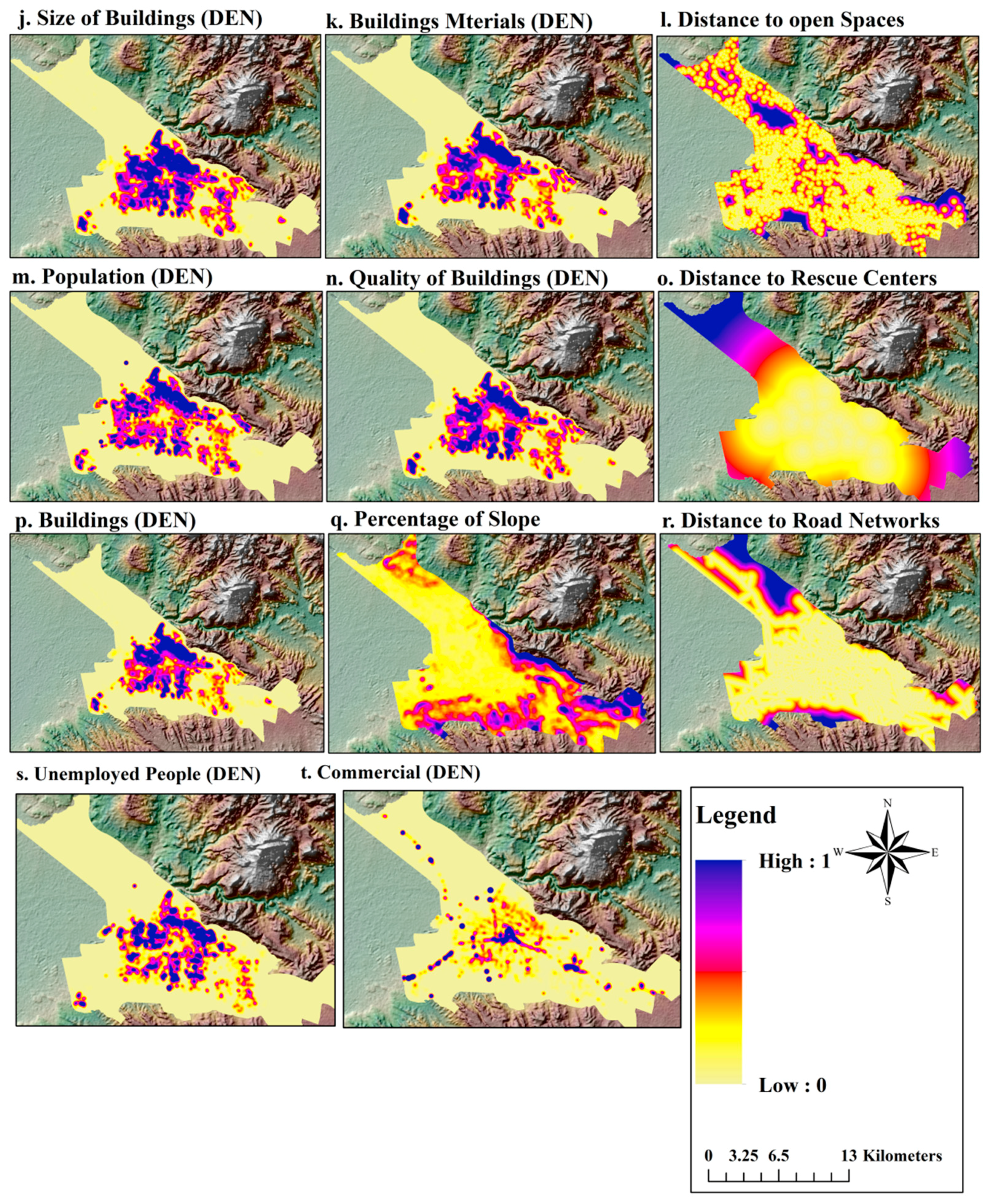
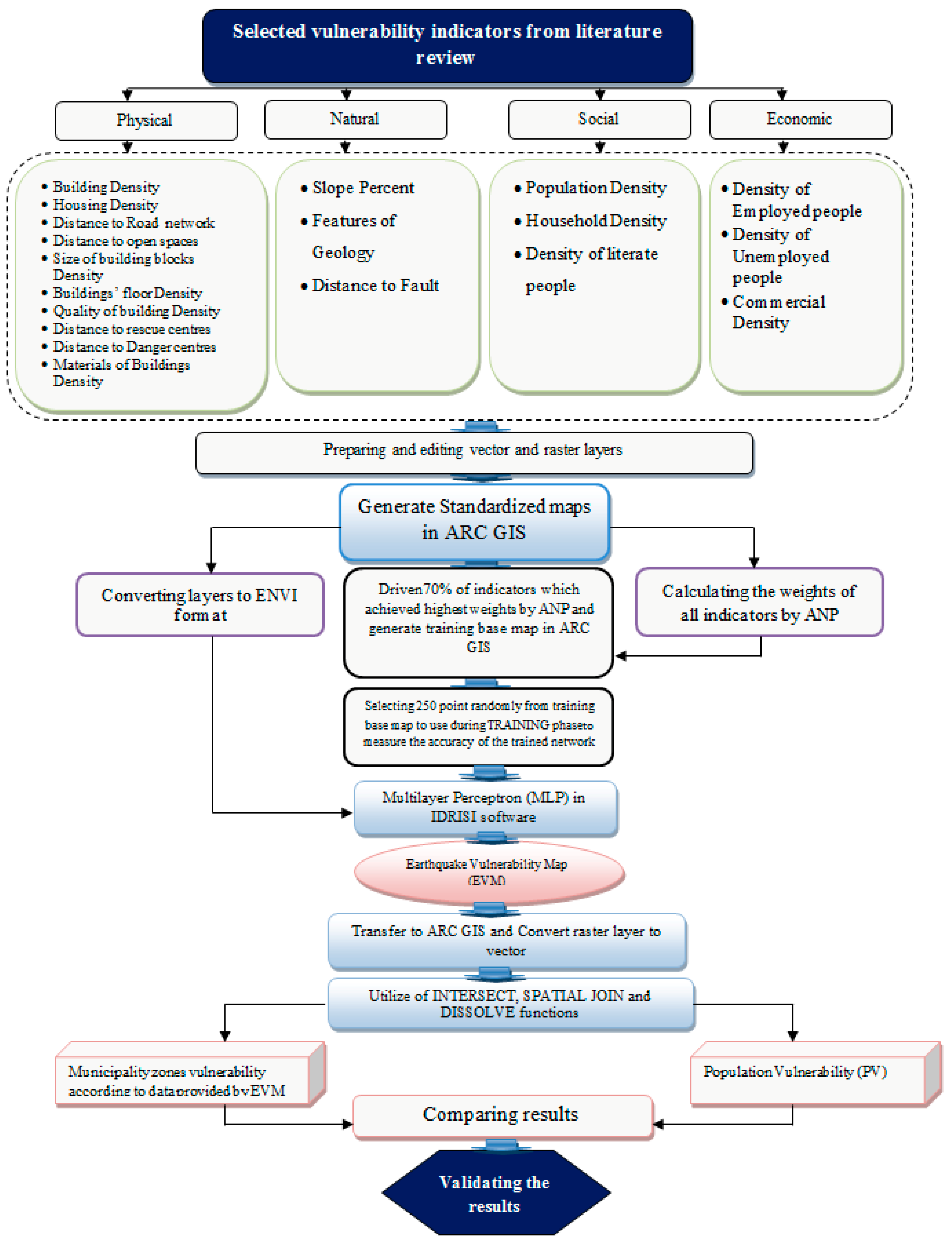
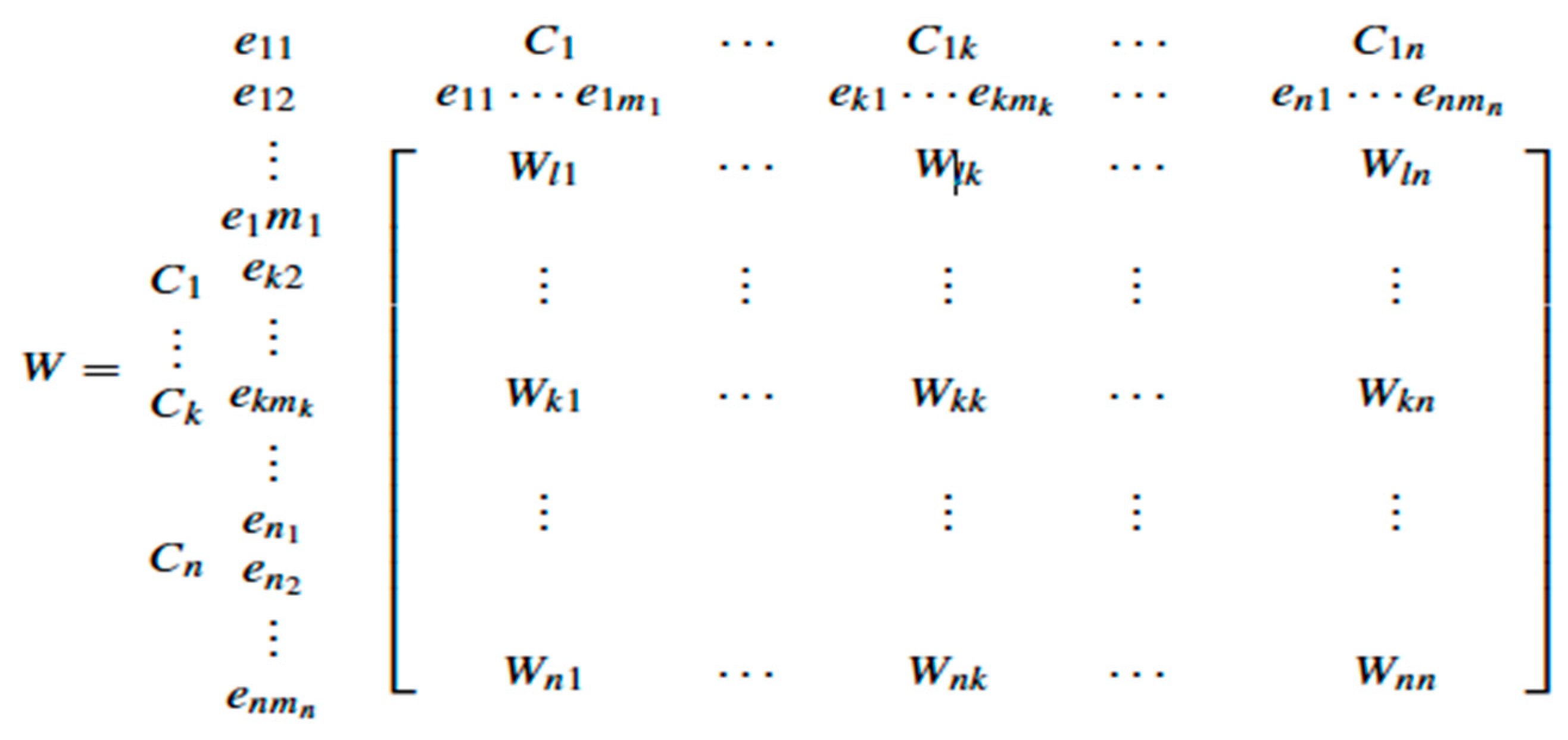
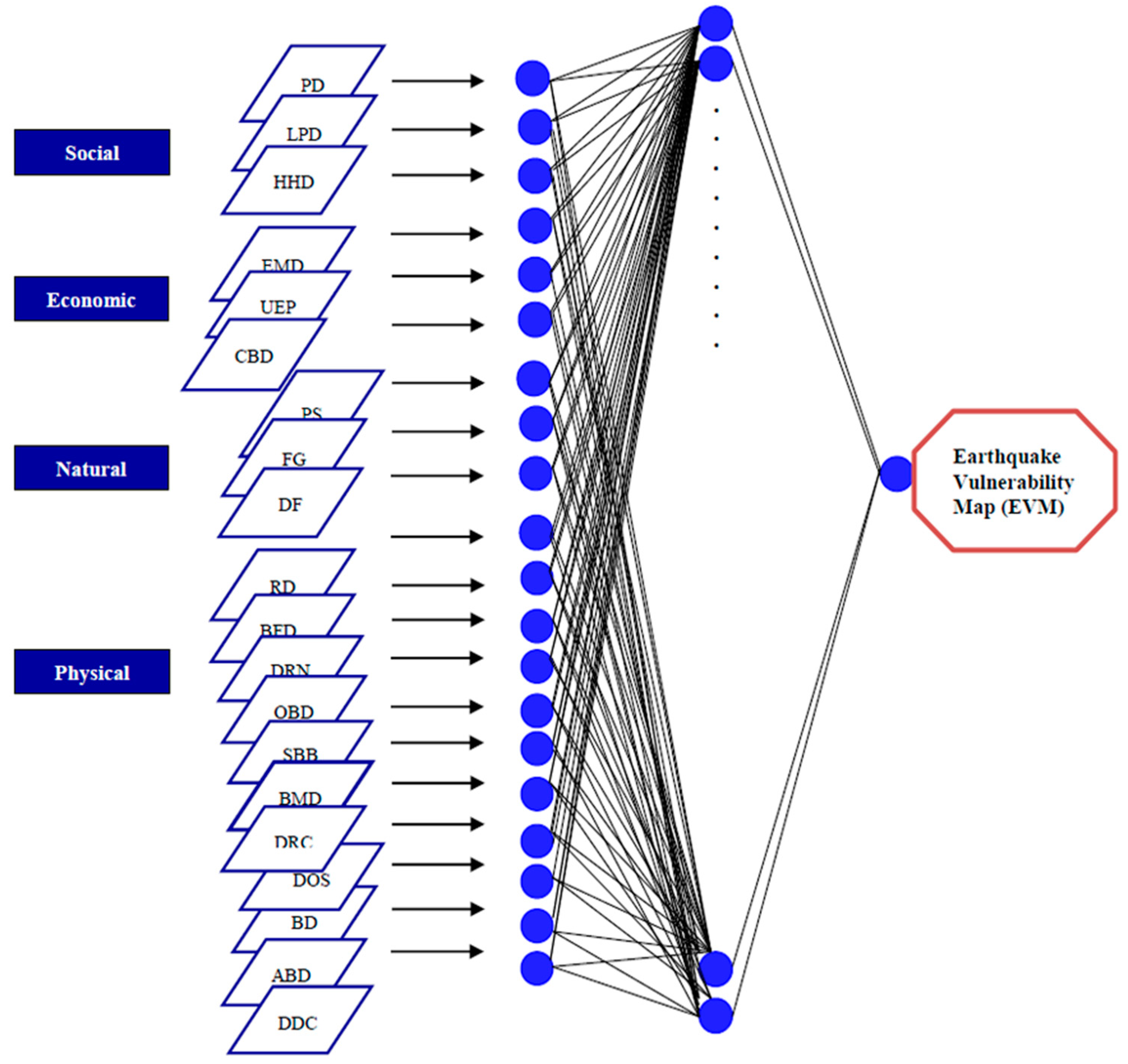
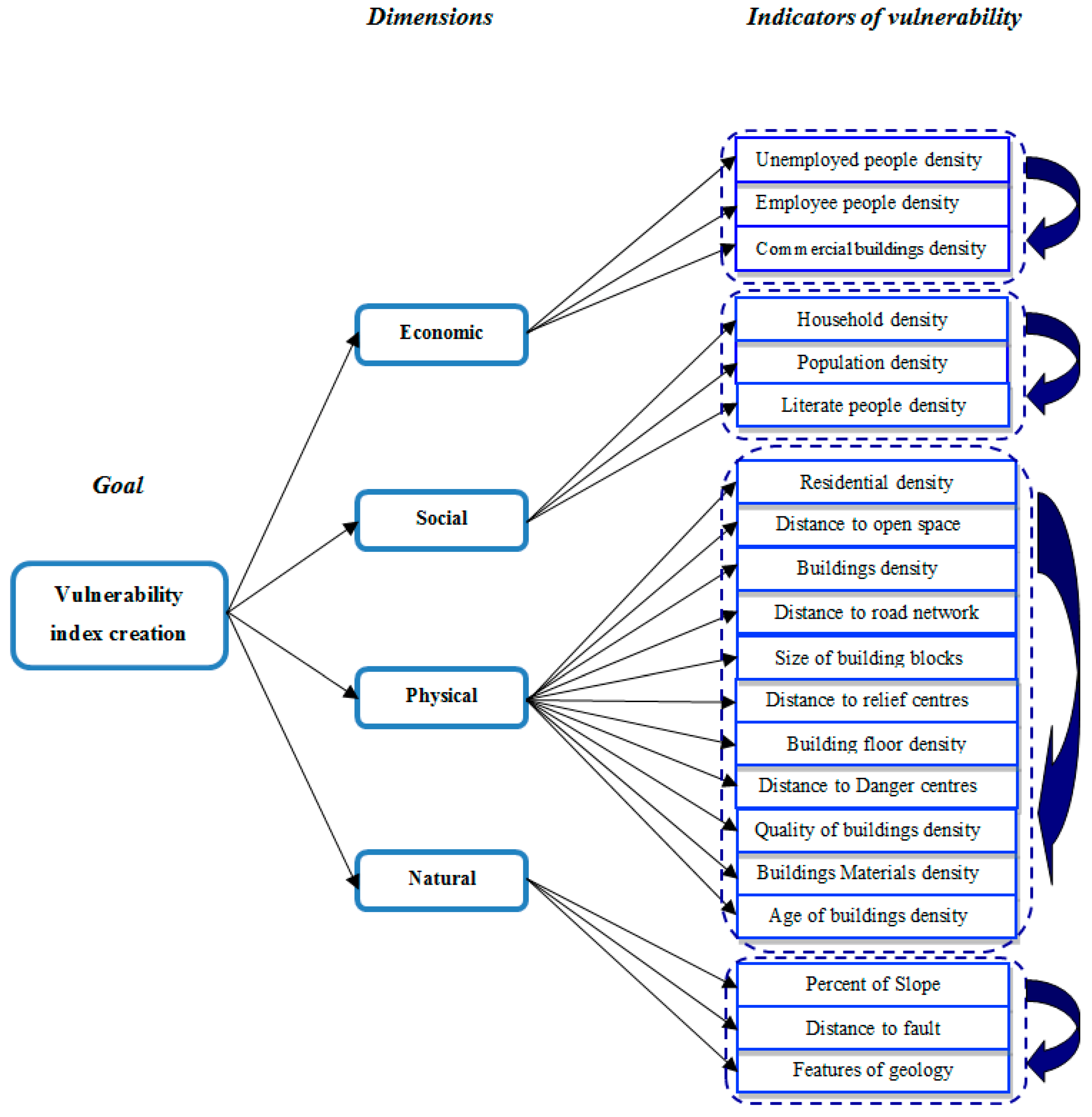
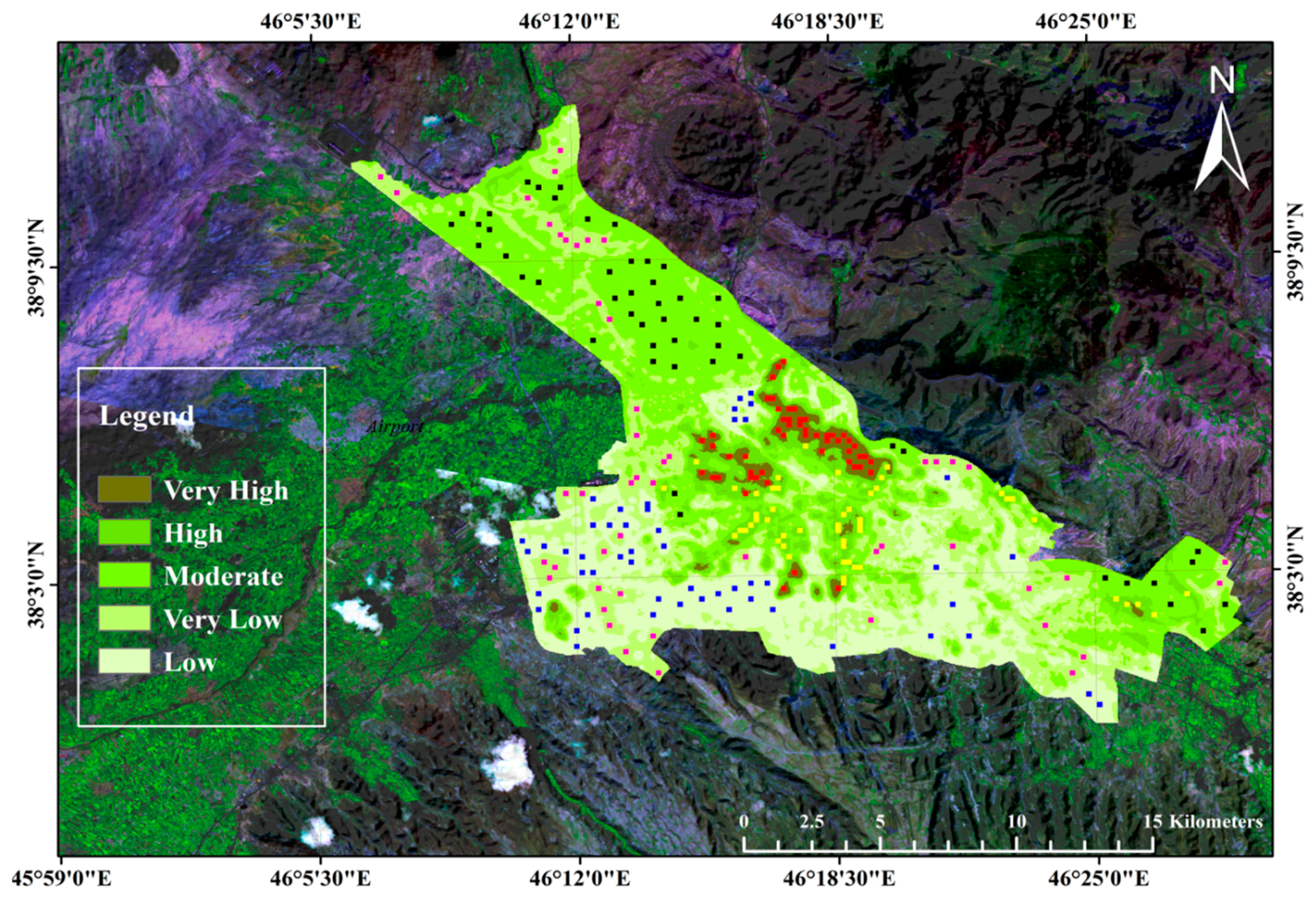
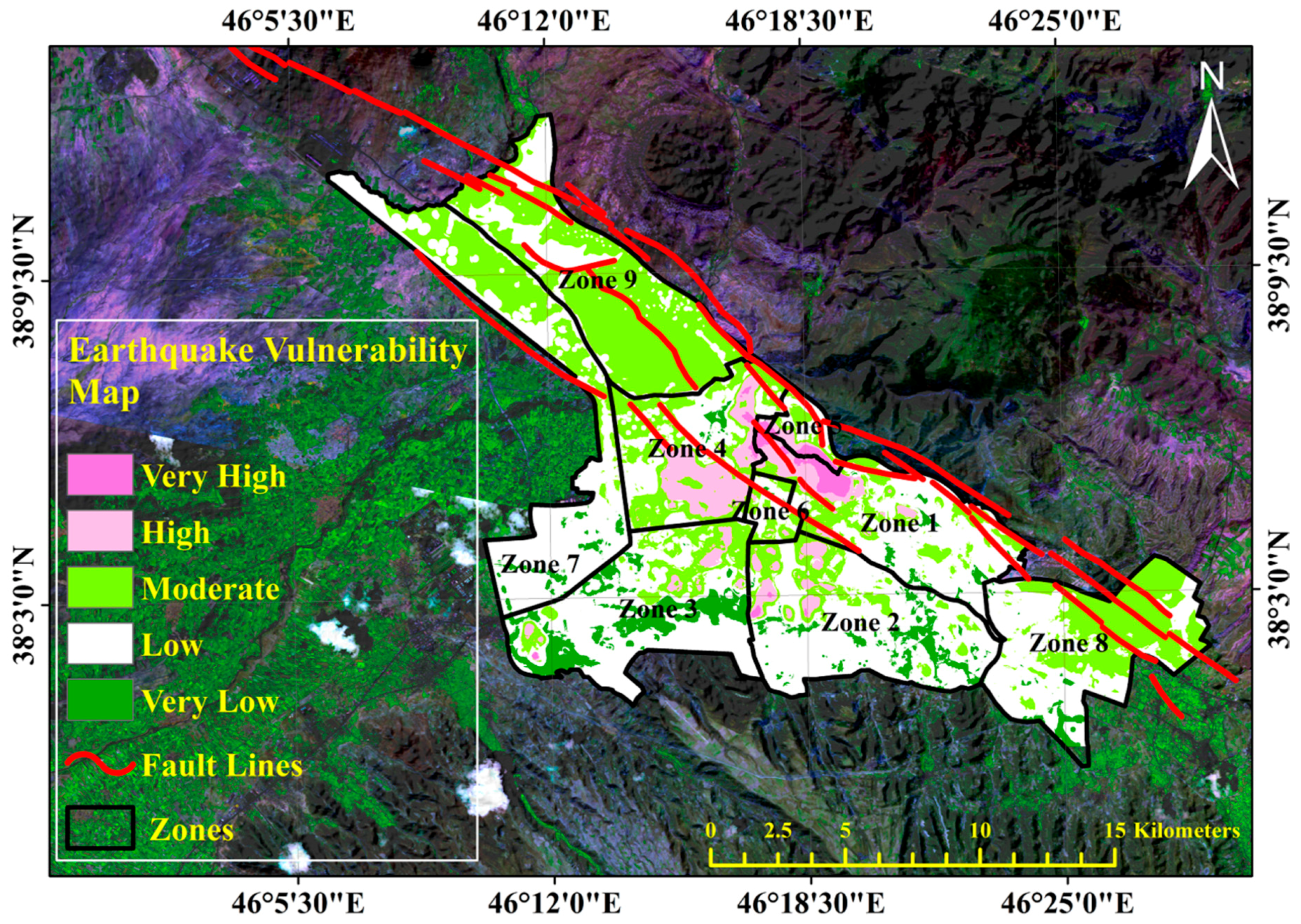
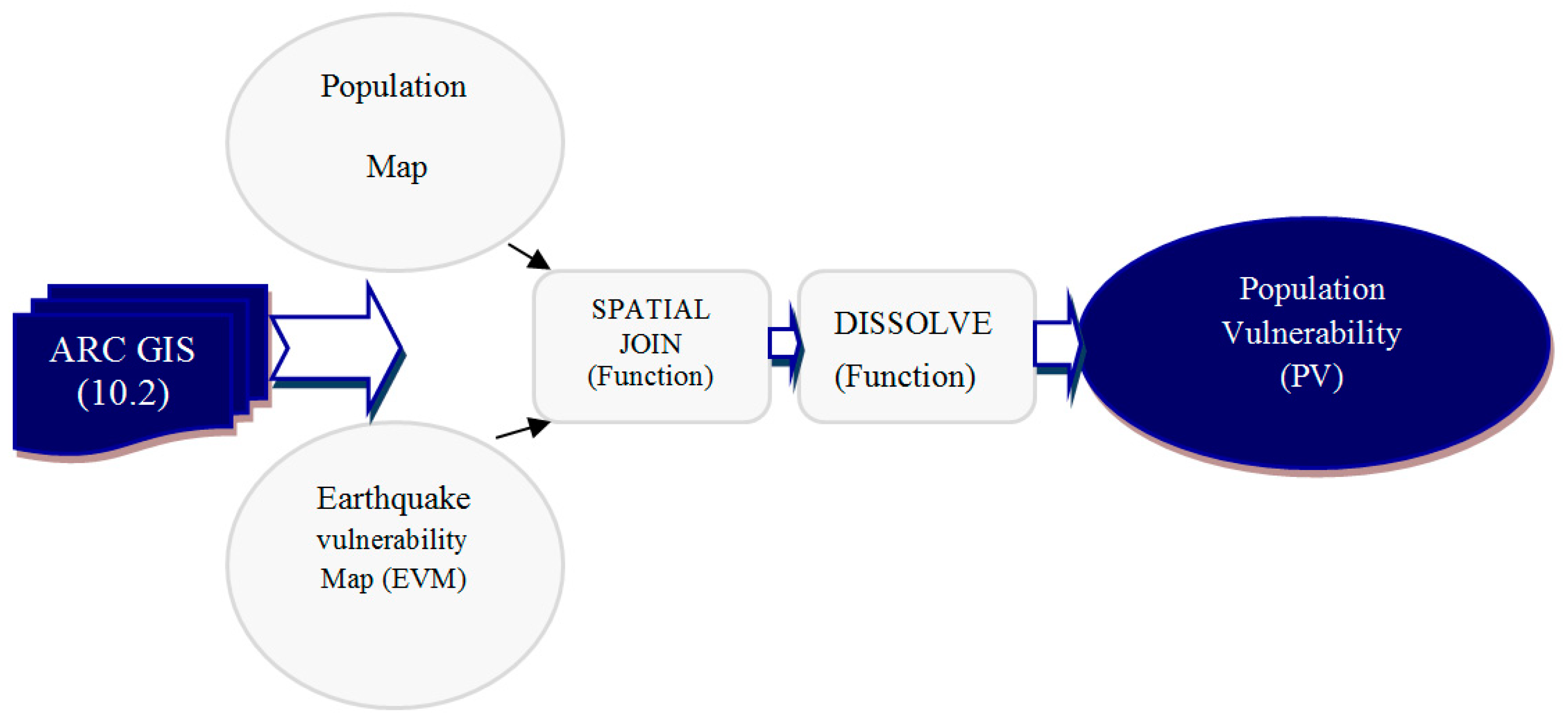
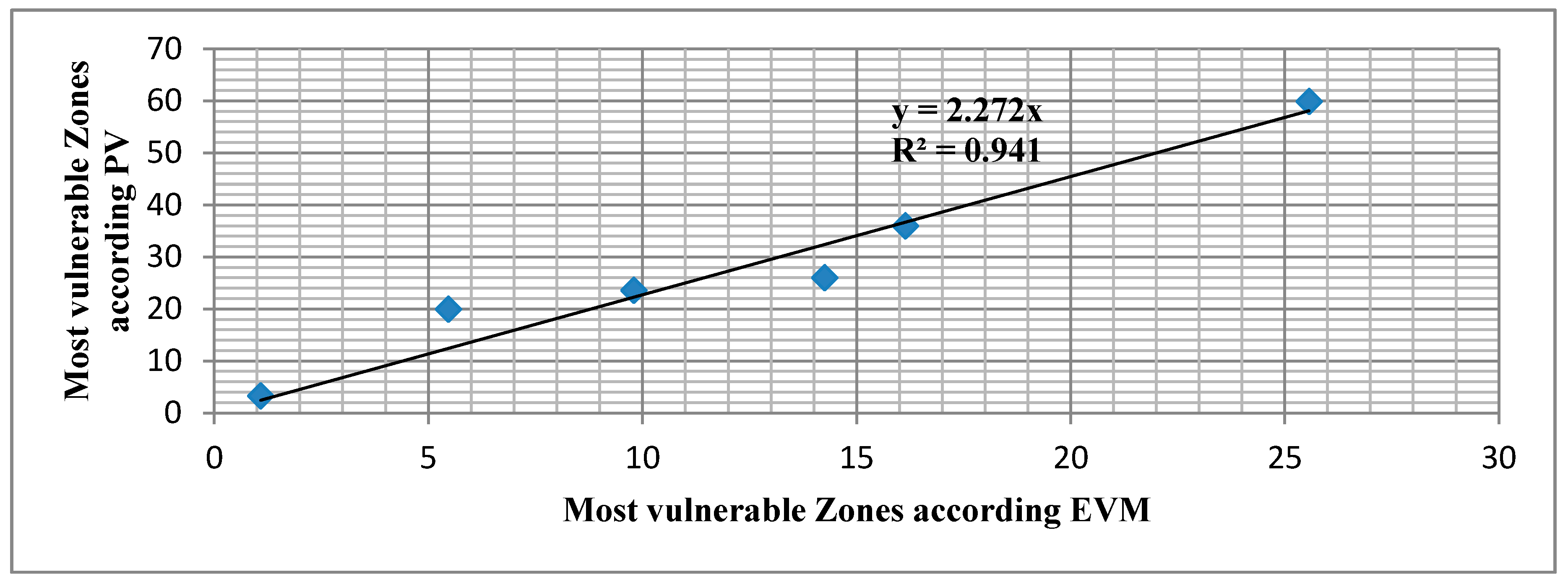
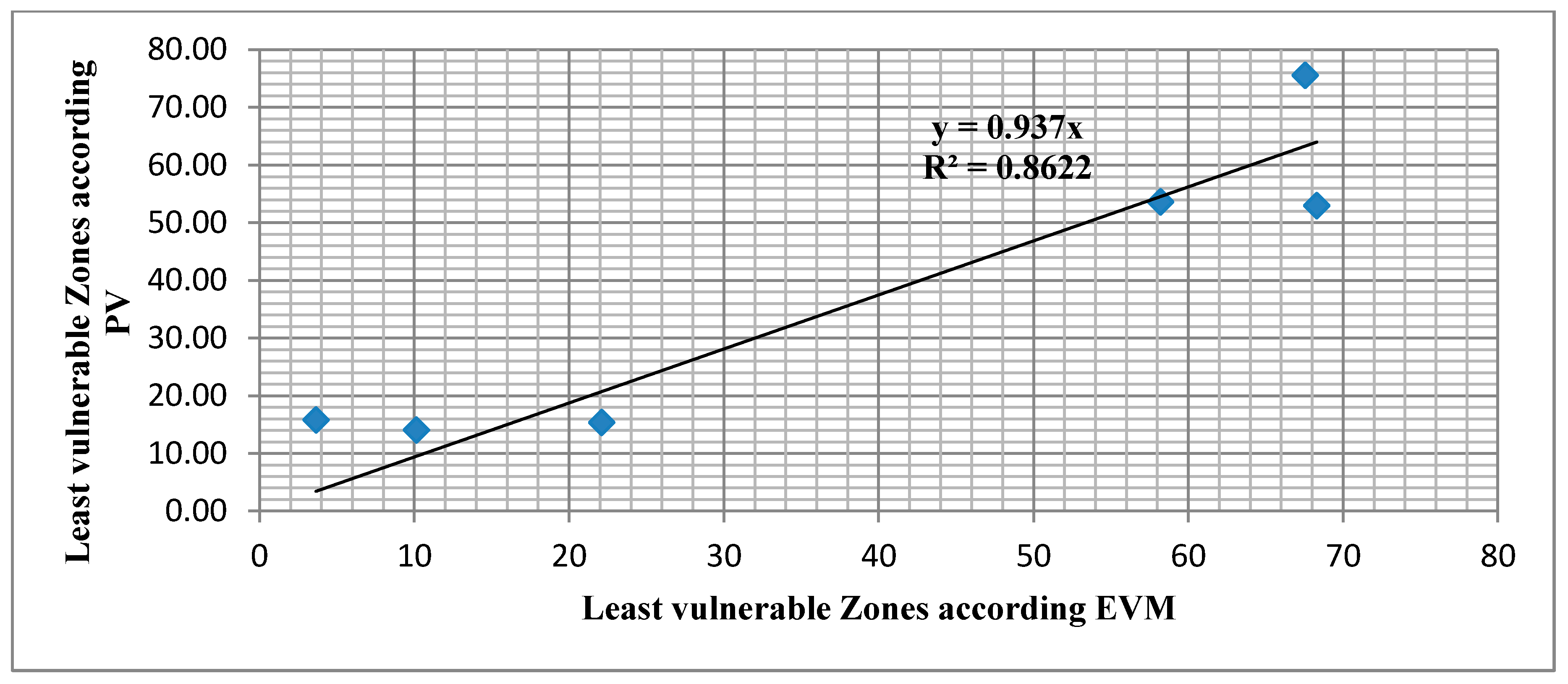
| Number | Year | Fatalities | Source | Description |
|---|---|---|---|---|
| 1 | 634 | - | B | |
| 2 | 694 | - | B | |
| 3 | 746 | - | B | |
| 4 | 838 | - | B | |
| 5 | 849 | - | B | |
| 6 | 858 | - | B-A | Half of the town was destroyed |
| 7 | 868 | - | B | |
| 8 | 949 | - | B | |
| 9 | 1020 | - | B | |
| 10 | 1040 | - | B | |
| 11 | 1042 | 40,000 | A-B | Most of the important structures were destroyed. |
| 12 | 1272 | - | B | Many houses were destroyed in Tabriz. |
| 13 | 1273 | 250 | A | 18 aftershocks occurred in the first 24 h. Aftershocks continued for 4 months. |
| 14 | 1314 | - | B | |
| 15 | 1345 | - | A | No destruction occurred. |
| 16 | 1441 | - | B | This event was probably related to Wan-Nimroud earthquake that had been associated with volcanic activity. |
| 17 | 1527 | - | B | |
| 18 | 1633 | - | B | |
| 19 | 1640 | - | B | |
| 20 | 1641 | 1200 | A-B | The earthquake happened between Tabriz and Urmia Lake. Osko, Khosrowshah, and Dehkharghan were destroyed. |
| 21 | 1668 | - | B | Tabriz and some parts of Caucasus were destroyed. |
| 22 | 1717 | 700 | A | Midnight earthquake destroyed more than 4000 houses. |
| 23 | 1721 | - | A-B | Many houses and monuments were destroyed. Rapture length reached to more than 55 km (between Tykmehdash and Tabriz) A lot of damages occurred in the area between Shebli and Gharebaba. |
| 24 | 1727 | 70,000 | A-B | |
| 25 | 1779 | 100,000 | B | |
| 28 | 1843 | - | A-B | A series of earthquakes of different intensities have been recorded by Khanikov. |
| 29 | 1870 | - | B | An earthquake shook Tabriz City. |
| 30 | 1896 | - | B | An earthquake was felt in Tabriz. |
| 31 | 1896 | - | B | An earthquake was felt in Tabriz. |
| Criteria | Indicators- Description | Scholars |
|---|---|---|
| Physical | 1. Building Density 2. Residential Density 3. Distance to road network 4. Distance to open space 5. Distance to police stations 6. Size of building block density 7. Building’s floor density 8. Quality of buildings density 9. Distance to relief centers 10. Distance to Danger centers 11. Buildings’ Materials density 12. Age of building density 13. Commercial building density | [72,73,74,75,76,77,78,79,80,81,82] |
| Environmental | 14. Percent of Slope 15. Features of geology 16. Average acceleration values for medium magnitude earthquake 17. Aspect 18. Drainage 19. Distance to fault | [82,83,84,85] |
| Social | 20. Population density 21. Percent of population under 6 years old 22. Household density 23. Percent of population over 65 years old 24. Literate People density 25. Ratio of widows in female population 26. Women with many children 27. Percent population with health insurance coverage 28. Percent of the population with telephone access 29. Percent females participating in labor force 30. Percent of housing units with bathroom 31. Percent of housing units with kitchen 32. Percent of population with disability 33. Percent of population who are migrants 34. Dentist per 100,000 population 35. Specialist physician per 100,000 population 36. Hospital beds per 100,000 population 37. Dwelling population density on census unit | [86,87,88,89,90,91,92,93] |
| Economic | 38. Employed People density 39. Unemployed people density 40. Degree of occupancy per room 41. Room area per person 42. private residences with more than 5 rooms 43. Percent of homeownership 44. Per capita household income | [93,94,95] |
| Criteria | Indicators-Description | Abbreviation | Scale | Source | Scholars |
|---|---|---|---|---|---|
| Physical | Building Density | BD | 1.2500 | 4 | [96,97,98,99,100,101,102,103,104,105] |
| Residential Density | RD | 1.2500 | 4 | ||
| Distance to the road network | DRN | 1.2500 | 1 | ||
| Distance to open space | DOS | 1.2500 | 1 | ||
| Size of building block density | 4 | ||||
| Building’s floor density | SBBD | 1.2500 | 4 | ||
| Quality of buildings density | BFD | 1.2500 | 5 | ||
| Distance to relief centers | QBD | 1.2500 | 1 | ||
| Distance to Danger centers | DRC | 1.2500 | 1 | ||
| Buildings’ Materials density | DDC | 1.2500 | 4 | ||
| Age of building density | BMD | 1.2500 | 4 | ||
| Commercial building density | ABD | 1.2500 | 4 | ||
| CBD | 1.2500 | 4 | |||
| Environmental | Percent of Slope | PS | - | 6 | [105,106] |
| Features of geology | PG | 1.100,000 | 2 | ||
| Distance to fault | DF | 1.100,000 | 1 | ||
| Social | Population density | PD | 1.10,000 | 3 | [107,108,109,110] |
| Household density | HD | 1.10,000 | 3 | ||
| Literate People density | LPD | 1.10,000 | 3 | ||
| Economic | Employed People density | EPD | 1.2500 | 3 | [108,109,110,111,112] |
| Unemployed people density | UPD | 1.2500 | 3 |
| Criteria | Environmental | Physical | Social | Economic | [W21] |
|---|---|---|---|---|---|
| Environmental | 1 | 0.89 | 1.38 | 1.15 | 0.24 |
| Physical | 1.11 | 1 | 1.55 | 1.29 | 0.61 |
| Social | 0.72 | 0.64 | 1 | 0.83 | 0.08 |
| Economic | 0.86 | 0.77 | 1.19 | 1 | 0.07 |
| Vulnerability Dimension | Indicators | Ideal | Normalized |
|---|---|---|---|
| Social | PD | 0.496 | 0.0511 |
| HHD | 0.337 | 0.0347 | |
| LPD | 0.088 | 0.0091 | |
| Economic | EMD | 0.373 | 0.0384 |
| UEPD | 0.120 | 0.0124 | |
| CBD | 0.040 | 0.0042 | |
| Physical | DRN | 0.443 | 0.0456 |
| DDC | 0.494 | 0.0509 | |
| DRC | 0.380 | 0.0392 | |
| DOS | 0.494 | 0.0509 | |
| RD | 0.842 | 0.0867 | |
| BD | 0.710 | 0.0731 | |
| ABD | 0.368 | 0.0379 | |
| BMD QBD | 0.781 | 0.0804 | |
| SBBD | 0.295 | 0.0304 | |
| B | 0.390 | 0.0402 | |
| BFD | 0.661 | 0.0681 | |
| Environmental | DF | 1 | 0.1029 |
| FG | 0.797 | 0.0821 | |
| PS | 0.598 | 0.0616 |
| Group | Parameter | Value |
|---|---|---|
| Input specifications | Avrg. training pixels per class | 500 |
| Avrg. testing pixels per class | 500 | |
| Network topology | Hidden layers | 1 |
| Nodes | 10 | |
| Input Layers Node | 20 | |
| Output Layer Nodes | 5 | |
| Training parameter | Automatic training | Yes |
| Dynamic learning rate | Yes | |
| Start Learning rate | 0.001 | |
| End learning rate | 0.0006 | |
| Momentum factor | 0.5 | |
| Stopping criteria | RMS | 0.1534 |
| Iterations | 10000 | |
| Accuracy rate | 90.00 |
| Vulnerability | Area (km2) | Hectares | Percentage (%) |
|---|---|---|---|
| Very High | 3.05 | 305.35 | 1.19 |
| High | 14.33 | 1433.05 | 5.60 |
| Moderate | 87.29 | 8729.49 | 34.11 |
| Low | 134.96 | 13,496.37 | 52.74 |
| Very Low | 16.25 | 1625.14 | 6.35 |
| Total | 255.894 | 25,589.40 | 100.00 |
| Zone | Vulnerability | Area (km2) | Hectares | Percentage (%) | Zone | Vulnerability | Area (km2) | Hectares | Percentage (%) |
| 1 | Very High | 1.177 | 177.99 | 5.74 | 2 | Very High | 0.167 | 16.79 | 0.44 |
| 1 | High | 3.04 | 304.13 | 9.80 | 2 | High | 2.22 | 222.38 | 5.80 |
| 1 | Moderate | 7.20 | 720.69 | 23.23 | 2 | Moderate | 5.87 | 587.55 | 15.32 |
| 1 | Low | 17.97 | 1797.46 | 57.94 | 2 | Low | 26.19 | 2619.24 | 68.30 |
| 1 | Very Low | 1.01 | 101.99 | 3.29 | 2 | Very Low | 3.88 | 388.92 | 10.14 |
| Sum | 31.02 | 3102.26 | 100.00 | Sum | 38.34 | 3834.88 | 100.00 | ||
| Zone | Vulnerability | Area (km2) | Hectares | Percentage | Zone | Vulnerability | Area (km2) | Hectares | Percentage |
| 3 | Very High | 0.05 | 5.15 | 0.14 | 4 | Very High | 0.29 | 29.72 | 1.08 |
| 3 | High | 1.22 | 122.99 | 3.29 | 4 | High | 7.06 | 706.21 | 25.57 |
| 3 | Moderate | 6.09 | 609.03 | 16.28 | 4 | Moderate | 9.86 | 986.83 | 35.73 |
| 3 | Low | 21.77 | 2177.86 | 58.20 | 4 | Low | 9.92 | 992.85 | 35.94 |
| 3 | Very Low | 8.26 | 826.83 | 22.10 | 4 | Very Low | 0.46 | 46.59 | 1.69 |
| Sum | 37.41 | 3741.85 | 100.00 | Sum | 27.62 | 2762.20 | 100.00 | ||
| Zone | Vulnerability | Area (km2) | Hectares | Percentage | Zone | Vulnerability | Area (km2) | Hectares | Percentage |
| 5 | Very High | 0.75 | 75.70 | 16.14 | 6 | High | 0.10 | 10.48 | 2.56 |
| 5 | High | 0.66 | 66.87 | 14.26 | 6 | Moderate | 1.69 | 169.41 | 41.41 |
| 5 | Moderate | 1.26 | 126.62 | 27.00 | 6 | Low | 2.24 | 224.57 | 54.90 |
| 5 | Low | 1.99 | 199.52 | 42.54 | 6 | Very Low | 0.04 | 4.61 | 1.13 |
| 5 | Very Low | 0.002 | 0.27 | 0.06 | Sum | 4.09 | 409.07 | 100.00 | |
| Sum | 4.68 | 468.97 | 100.00 | ||||||
| Zone | Vulnerability | Area (km2) | Hectares | Percentage | Zone | Vulnerability | Area (km2) | Hectares | Percentage |
| 7 | Moderate | 10.88 | 1088.19 | 28.80 | 8 | Moderate | 15.21 | 1521.90 | 43.68 |
| 7 | Low | 25.52 | 2552.61 | 67.55 | 8 | Low | 18.47 | 1847.70 | 53.04 |
| 7 | Very Low | 1.37 | 137.96 | 3.65 | 8 | Very Low | 1.14 | 114.30 | 3.28 |
| Sum | 37.78 | 3778.76 | 100.00 | Sum | 34.83 | 3483.91 | 100.00 | ||
| Zone | Vulnerability | Area (km2) | Hectares | Percentage | |||||
| 9 | Moderate | 29.17 | 2917.45 | 72.86 | |||||
| 9 | Low | 10.84 | 1084.37 | 27.08 | |||||
| 9 | Very Low | 0.02 | 2.13 | 0.05 | |||||
| Sum | 40.03 | 4003.95 | 100.00 |
| Zone | Vulnerability | Households | Population | Percentage | Zone | Vulnerability | Households | Population | Percentage |
| 1 | Very High | 18,409 | 73,291 | 19.97 | 2 | Very High | 2130 | 8524 | 2.83 |
| 1 | High | 23,054 | 86,647 | 23.61 | 2 | High | 13,642 | 50,333 | 16.73 |
| 1 | Moderate | 25,874 | 92,800 | 25.28 | 2 | Moderate | 6884 | 40,226 | 13.37 |
| 1 | Low | 30,862 | 111,987 | 30.51 | 2 | Low | 52,006 | 159,478 | 52.99 |
| 1 | Very Low | 640 | 2333 | 0.64 | 2 | Very Low | 7548 | 42,382 | 14.08 |
| SUM | 98,839 | 367,058 | 100.00 | SUM | 82,210 | 300,943 | 100.00 | ||
| Zone | Vulnerability | Households | Population | Percentage | Zone | Vulnerability | Households | Population | Percentage |
| 3 | Very High | 470 | 1929 | 0.72 | 4 | Very High | 2647 | 10,553 | 3.30 |
| 3 | High | 9583 | 33,376 | 12.50 | 4 | High | 51,908 | 185,501 | 58.06 |
| 3 | Moderate | 14,695 | 47,415 | 17.76 | 4 | Moderate | 17,562 | 69,485 | 21.75 |
| 3 | Low | 48,256 | 143,159 | 53.63 | 4 | Low | 13,416 | 52,047 | 16.29 |
| 3 | Very Low | 1408 | 41,080 | 15.39 | 4 | Very Low | 508 | 1892 | 0.59 |
| SUM | 74,376 | 266,959 | 100.00 | SUM | 86,041 | 319,478 | 100.00 | ||
| Zone | Vulnerability | Households | Population | Percentage | Zone | Vulnerability | Households | Population | Percentage |
| 5 | Very High | 7436 | 31,441 | 35.99 | 6 | High | 358 | 1132 | 3.82 |
| 5 | High | 5351 | 22,755 | 26.05 | 6 | Moderate | 6391 | 20,718 | 69.84 |
| 5 | Moderate | 4768 | 19,860 | 22.74 | 6 | Low | 2233 | 7816 | 26.35 |
| 5 | Low | 3298 | 13,294 | 15.22 | SUM | 8982 | 29,666 | 100.00 | |
| SUM | 20,853 | 87,350 | 100.00 | 82,210 | 300,943 | ||||
| Zone | Vulnerability | Households | Population | Percentage | Zone | Vulnerability | Households | Population | Percentage |
| 7 | Moderate | 132 | 1570 | 8.58 | 8 | Moderate | 90 | 488 | 66.67 |
| 7 | Low | 4803 | 13,822 | 75.58 | 8 | Low | 32 | 145 | 19.81 |
| 7 | Very Low | 62 | 2896 | 15.84 | 8 | Very Low | 18 | 89 | 12.16 |
| SUM | 4997 | 18,288 | 100.00 | SUM | 140 | 732 | 100.00 | ||
| Zone | Vulnerability | Households | Population | Percentage | |||||
| 9 | Moderate | 2022 | 7586 | 100.00 | |||||
| SUM | 2022 | 7586 | 100.00 |
| VAR00002 | VAR00003 | ||
|---|---|---|---|
| VAR00002 | Pearson Correlation | 1 | 0.976 ** |
| Sig. (2-tailed) | 0.001 | ||
| N | 6 | 6 | |
| VAR00003 | Pearson Correlation | 0.976 ** | 1 |
| Sig. (2-tailed) | 0.001 | ||
| N | 6 | 6 |
| VAR00001 | VAR00002 | ||
|---|---|---|---|
| VAR00001 | Pearson Correlation | 1 | 0.940 ** |
| Sig. (2-tailed) | 0.005 | ||
| N | 6 | 6 | |
| VAR00002 | Pearson Correlation | 0.940 ** | 1 |
| Sig. (2-tailed) | 0.005 | ||
| N | 6 | 6 | |
© 2018 by the authors. Licensee MDPI, Basel, Switzerland. This article is an open access article distributed under the terms and conditions of the Creative Commons Attribution (CC BY) license (http://creativecommons.org/licenses/by/4.0/).
Share and Cite
Alizadeh, M.; Ngah, I.; Hashim, M.; Pradhan, B.; Pour, A.B. A Hybrid Analytic Network Process and Artificial Neural Network (ANP-ANN) Model for Urban Earthquake Vulnerability Assessment. Remote Sens. 2018, 10, 975. https://doi.org/10.3390/rs10060975
Alizadeh M, Ngah I, Hashim M, Pradhan B, Pour AB. A Hybrid Analytic Network Process and Artificial Neural Network (ANP-ANN) Model for Urban Earthquake Vulnerability Assessment. Remote Sensing. 2018; 10(6):975. https://doi.org/10.3390/rs10060975
Chicago/Turabian StyleAlizadeh, Mohsen, Ibrahim Ngah, Mazlan Hashim, Biswajeet Pradhan, and Amin Beiranvand Pour. 2018. "A Hybrid Analytic Network Process and Artificial Neural Network (ANP-ANN) Model for Urban Earthquake Vulnerability Assessment" Remote Sensing 10, no. 6: 975. https://doi.org/10.3390/rs10060975
APA StyleAlizadeh, M., Ngah, I., Hashim, M., Pradhan, B., & Pour, A. B. (2018). A Hybrid Analytic Network Process and Artificial Neural Network (ANP-ANN) Model for Urban Earthquake Vulnerability Assessment. Remote Sensing, 10(6), 975. https://doi.org/10.3390/rs10060975









